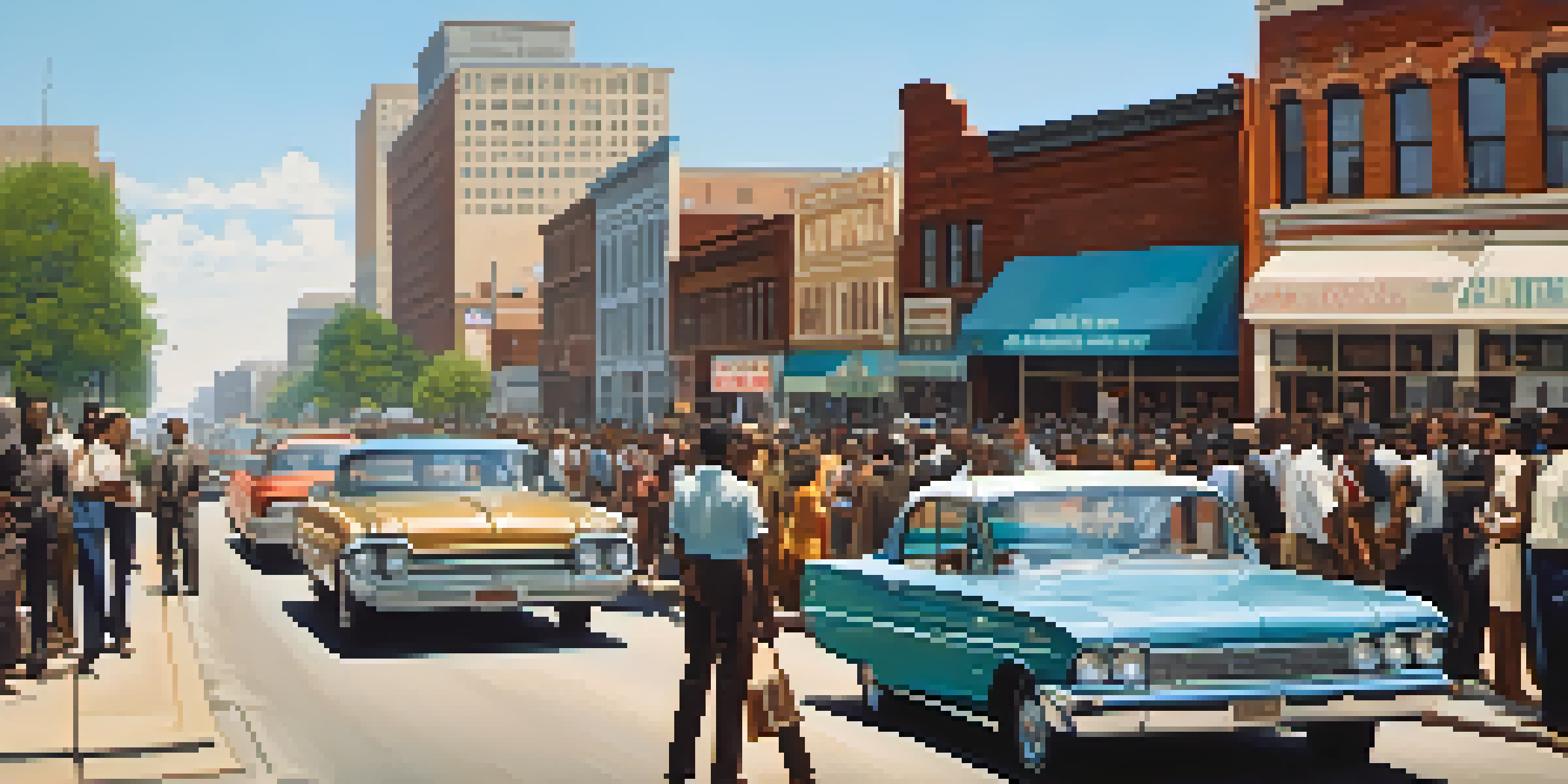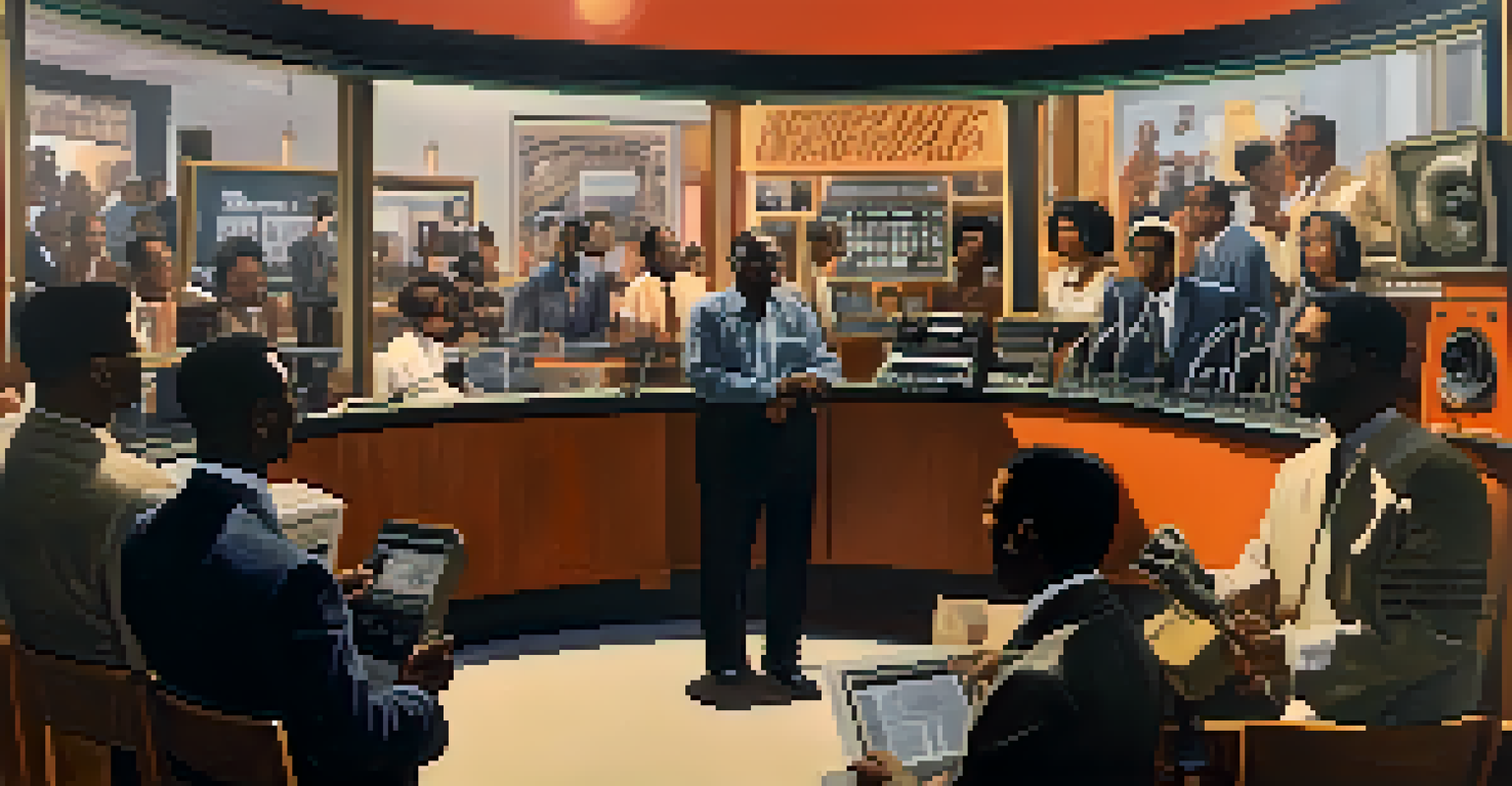The Role of Radio and Media in Detroit's Civil Rights Movement

Introduction to Detroit's Civil Rights Movement
Detroit's civil rights movement was a crucial chapter in American history, marked by a collective fight against racial injustice. During the 1950s and 1960s, the city became a hub for activism, driven by both local leaders and national organizations. As the struggle for equality intensified, media, particularly radio, played a pivotal role in shaping public perception and mobilizing support.
The media's role in the civil rights movement was not merely to report the news, but to create a community of resistance and hope.
Activists such as Rosa Parks and the Detroit chapter of the NAACP worked tirelessly to address issues like segregation and voting rights. The challenges they faced were immense, but the power of communication via radio and print media helped amplify their voices. Understanding this dynamic is essential to grasping the full impact of the civil rights movement in Detroit.
Through grassroots efforts and community organizing, Detroiters began to see the media as a tool for empowerment. This laid the foundation for how information would be disseminated and highlighted the critical role of media in social change.
The Rise of Radio as a Communication Tool
In the midst of Detroit's civil rights activism, radio emerged as a powerful communication tool. Local stations began to broadcast discussions and interviews that highlighted the struggles of African Americans in the city. This allowed activists to reach a broader audience and share their messages in real-time, creating a sense of urgency around civil rights issues.

Programs that focused on social justice and equality helped educate listeners about the ongoing struggles for civil rights. This not only informed the public but also inspired many to join the movement. For instance, radio shows often featured prominent activists, allowing them to articulate their vision for change directly to the community.
Radio's Role in Activism
During Detroit's civil rights movement, radio served as a vital communication tool, enabling activists to reach broader audiences and mobilize support.
Moreover, the accessibility of radio made it a preferred medium for reaching diverse audiences, including those who may not have had access to print media. This democratization of information played a crucial role in rallying support for civil rights initiatives across Detroit.
Media Coverage of Key Events
Key events in Detroit's civil rights movement, such as protests and rallies, garnered significant media coverage. Newspapers and radio stations reported on these gatherings, bringing attention to the demands for equality and justice. This coverage helped to create a narrative around the movement, showcasing the determination of activists.
Injustice anywhere is a threat to justice everywhere.
For example, the 1963 Detroit Walk to Freedom, which attracted over 125,000 participants, was heavily covered by both radio and print media. This event not only highlighted the unity within the civil rights community but also drew national attention to the issues facing African Americans in Detroit. The media's portrayal of such events often influenced public opinion and political responses.
Effective media coverage also played a role in documenting the movement's history. By capturing the voices and stories of those involved, it contributed to a richer understanding of the challenges and triumphs experienced during this pivotal time.
The Role of Local Activists in Media
Local activists recognized the importance of media in advancing their cause and began to engage with it strategically. Many activists took to the airwaves, hosting radio shows that discussed civil rights issues. This direct involvement allowed them to present their perspectives and challenge mainstream narratives that often marginalized their experiences.
By participating in media discussions, activists could directly influence how their stories were told. This was particularly important in a time when mainstream media often overlooked or misrepresented the struggles of African Americans. Their engagement helped ensure that the voices of those fighting for civil rights were heard loud and clear.
Media Coverage of Key Events
Media coverage of significant events, like the 1963 Detroit Walk to Freedom, played a crucial role in shaping public perception and highlighting the struggle for equality.
Furthermore, this grassroots approach to media engagement fostered a sense of community. It empowered individuals to share their stories and experiences, creating a collective narrative that resonated with many in Detroit and beyond.
The Impact of Print Media
While radio played a crucial role, print media also contributed significantly to the civil rights movement in Detroit. Newspapers published articles that highlighted local struggles and celebrated victories, creating a sense of solidarity among readers. Publications like the Michigan Chronicle became essential platforms for discussing civil rights issues and promoting awareness.
Print media helped to document the movement's history, serving as a record of events and discussions that shaped public opinion. Coverage of protests, community meetings, and legal battles provided context for the struggles faced by African Americans in Detroit. This documentation was vital for future generations seeking to understand the movement's legacy.
Moreover, print media facilitated dialogue among different communities, encouraging conversations about race and justice. By sharing stories and experiences across various platforms, the movement gained traction and support from individuals who may not have been directly involved.
Influence of National Media
The national media landscape also played a role in Detroit's civil rights movement, particularly as local stories gained national attention. Coverage by major news outlets helped to shine a spotlight on the challenges faced by African Americans in Detroit, prompting broader discussions about civil rights across the country. This national focus often brought resources and support to local activists.
For instance, when the Detroit riots of 1967 occurred, national media coverage intensified, drawing attention to systemic issues of race and inequality. The portrayal of these events helped to frame the narrative around civil rights, influencing public perception and policy discussions at higher levels of government.
Legacy of Media Engagement
The strategies used by Detroit activists in engaging with media continue to influence contemporary movements, demonstrating the enduring power of communication in social justice.
Additionally, national media coverage provided a platform for local activists to share their messages beyond Detroit. This not only amplified their voices but also connected them with other movements across the country, fostering a sense of solidarity among those fighting for justice.
Legacy of Media in the Civil Rights Movement
The impact of radio and media in Detroit's civil rights movement continues to resonate today. The strategies employed by activists in engaging with media serve as a blueprint for contemporary movements seeking social change. Understanding how media was used to amplify voices and mobilize communities is crucial for anyone looking to effect change.
Moreover, the legacy of this media engagement is evident in the way modern movements utilize social media and digital platforms. Activists today draw inspiration from their predecessors, using technology to disseminate information rapidly and reach a global audience. This evolution highlights the enduring importance of communication in activism.

As we reflect on the role of radio and media in Detroit's civil rights movement, it's clear that these tools were not just passive observers but active participants in the fight for justice. They helped shape the narrative, uplift voices, and mobilize communities, leaving a lasting impact on the quest for equality.